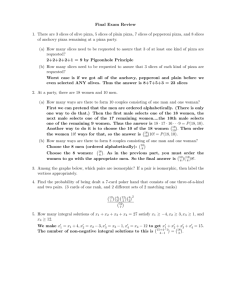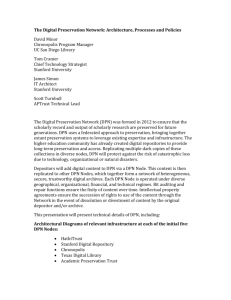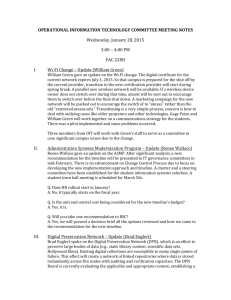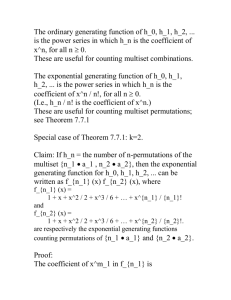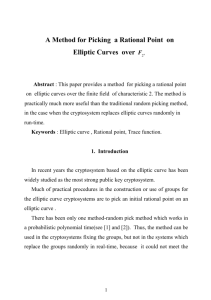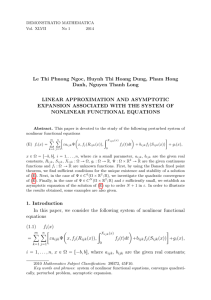Math 378 Spring 2011 Assignment 5 Solutions
advertisement
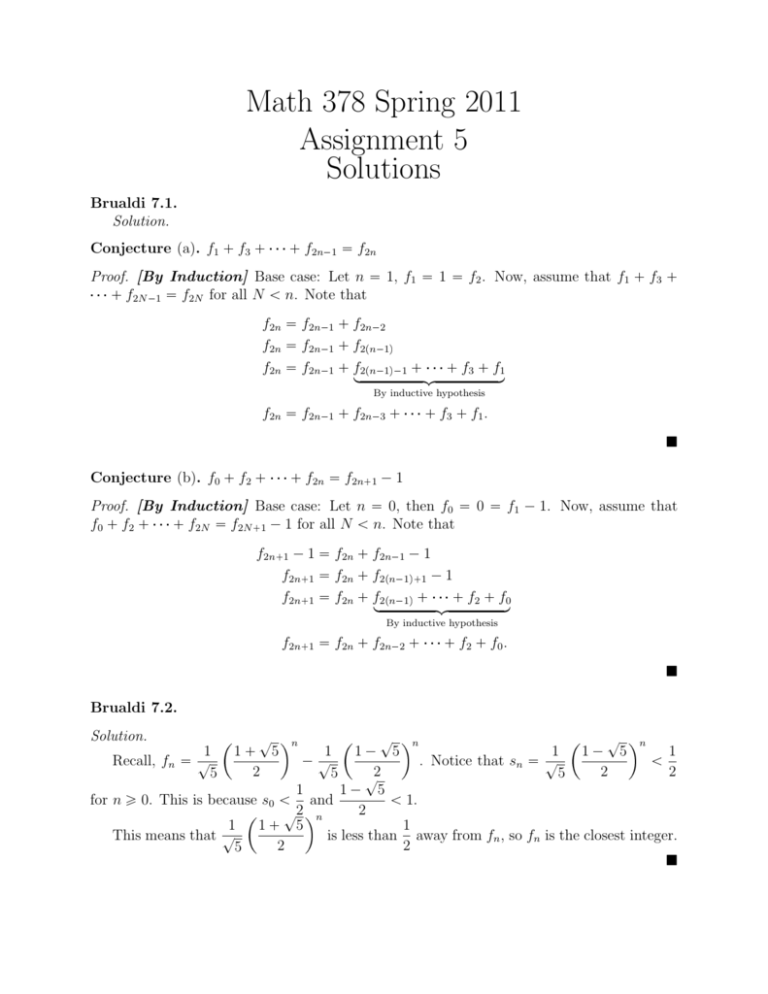
Math 378 Spring 2011
Assignment 5
Solutions
Brualdi 7.1.
Solution.
Conjecture (a). f1
f3
f2n
Let n 1, f1 1 f2 .
f2n1
Proof. [By Induction] Base case:
f2N 1 f2N for all N n. Note that
f2n
f2n
f2n
f2n
f2n1
f2n1
f2n1
f2n1
Now, assume that f1
f3
f2n2
f2pn1q
f2pn1q1 f3 f1
loooooooooooooomoooooooooooooon
By inductive hypothesis
f2n3
f3
f1 .
f2n 1 1
Proof. [By Induction] Base case: Let n 0, then f0 0 f1 1.
f0 f2 f2N f2N 1 1 for all N n. Note that
f2n 1 1 f2n f2n1 1
f2n 1 f2n f2pn1q 1 1
f2n 1 f2n looooooooooooomooooooooooooon
f2pn1q f2 f0
Conjecture (b). f0
f2
f2n
f2n
1
f2n
Now, assume that
By inductive hypothesis
f2n2
f2
f0 .
Brualdi 7.2.
Solution.
?
n
?
n
?
n
1 5
1
1 5
1
. Notice that sn ?
Recall, fn 2
2
2
5
?2
1
1 5
for n ¥ 0. This is because s0 and
1.
2
?2 n
1
1
5
1
is less than away from fn , so fn is the closest integer.
This means that ?
2
2
5
?1
5
1
5
?1
5
Brualdi 7.3.
Solution.
(a). [By Induction] Note that f1 1, f2 1 and f3 2 satisfying the base cases for
induction. Now, assume that fn is even ðñ N is divisible by 3 for all N n.
Method 1:
Suppose 3 | n. Then 3 n 1 and 3 n 2. This means that fn1 and fn2 are odd, so
fn fn1 fn2 is even.
Suppose 3 n. Then either 3 n 1 or 3 n 2 but not both. This means either fn1
or fn2 is even and the other is odd which implies that fn fn1 fn2 is odd (since it is
the sum of an odd and even number).
Method 2:
Note that
fn1 fn2
fn2 fn3 fn2
2fn2 fn3
ðñ 2 p2fn2 fn3q ðñ 2 fn3.
fn
fn
fn
Now we have 2 fn
()
(b). [By Induction] Note that f1 1, f2 1, f3 2 and f4 3 satisfying the base cases
for induction. Now, assume that fn is divisible by 3 ðñ 4 N for all N n.
Method 1:
We will consider the Fibonacci numbers modulo 4 for convenience (not necessary but
it makes the argument easier/shorter). Note that f1 1 pmod 3q, f2 1 pmod 3q, f3 2
pmod 3q and f4 0 pmod 3q and the inductive hypothesis is fn 0 pmod 3q ðñ 4 N
for all N n. We now proceed similarly to Method 1 above, but the argument is more
involved/complicated.
Method 2:
Continuing from () above we have
fn
fn
fn
Note that 3 fn
ðñ 3 p3fn2
2fn2 fn3
2pfn3 fn4q fn3
3fn3 fn4
fn4 q ðñ 3 fn4 .
()
Brualdi 7.8.
Solution.
Let hn be the number of ways of coloring a 1 n chessboard where each square is red or
blue and no two adjacent squares are colored red. The first square of the coloring must be
either red or blue.
If it is blue, then the number of ways of coloring the other n 1 squares is hn1 .
If it is red, then the next square must be blue since two reds cannot be adjacent. There
are then hn2 ways to color the rest.
This means the recurrence relation is hn hn1 hn2 for n ¥ 2 with h0 1 and
h1 2.
Brualdi 7.9.
Solution.
Let hn be the number of ways of coloring a 1 n chessboard where each square is red,
white or blue and no two adjacent squares are colored red. The first square of the coloring
must be either red, white or blue.
If it is blue, then the number of ways of coloring the other n 1 squares is hn1 .
If it is white, then it is also hn1 .
If it is red, then the next square must be either blue or white (2 options) and the rest
can be filled in hn2 ways.
This means the recurrence relation is hn 2hn1 2hn2 for n ¥ 2 with h0 1 and
h1 3.
Brualdi 7.10.
Solution.
This is equivalent to: “Use the recurrence gn gn1 gn2 and initial values g0 0 and
g1 2. Find g13 . More generally, find fn .”
Method 1:
I’ll find a function for gn and use it to recover g13 although you can use the recurrence
to do g13 pretty reasonably.
To solve this recurrence, I use exactly the method I showed for fn in class. First, we
write the recurrence as gn gn1 gn2 0 for n ¥ 2. Now, the characteristic equation is
x2 x 1 0 which (according to the quadratic formula) has solutions
q1
So we know that
gn
c1
?
1
5
2
1
?
2
,
5
q2
n
c2
?
1 5
2
?
1 5
2
n
Utilizing our initial values we find
0 c1
Note that c2
2 c1
c2 ,
1
?
5
c2
2
?
1 5
2
c1, so replacing this into the second equation we find
?
?
1
5 1 5
2 c1
2
2
?
2 c1 5
?2 c1 ùñ c2 ?2
5
? n 5 ? n
2
1
5
So, g ?
?2 1 5 .
n
2
5
2
5
This means that g13 466.
Method 2:
Note that g0 0 2f0 , g1 2 2f1 and the recurrence is the same as fn . This
means that gn 2fn which is easily shown by induction (we’ve done the base cases already).
Assume gN 2fN for all N n. Observe,
gn
gn1
gn2
2fn1
2pfn1
2fn.
2fn2
fn2 q
233, so g13 466. Also, we know that
? n
? n
5
1
1
1 5
1
?
fn ?
2
5
? n 5 2? n
2
1
5
2
1 5
?
So, gn 2fn ?
.
2
2
Now we already know f13
5
5
Brualdi 7.13.
Solution.
(a)
g p xq 1
8̧
cx
pcxqn
n 0
1 1 cx
c2 x 2
cn x n
(b)
g pxq 1 x
8̧
x2 x3
x4 p1qnxn pxqn
n 0
11x
(c)
g pxq α
0
8̧
α 2
x 2
α
x
1
p1q
n
n 0
p1qn
α n
x
n
α n
x
n
p1 xqα
(d)
g pxq 1
1 2
1
x
x
1!
2!
8̧ 1
n! xn
n0
1 n
x
n!
ex
(e)
g pxq 1 1 2
x 2!
8̧
p1qn n!1 xn
n0
1
x
1!
p1qn n!1 xn e x
Brualdi 7.14.
Solution.
(a)
g p xq x
x3
xp 1
(b)
4
x
1 x2
g pxq 1
x2
4
4
x4 q
x5
x3
1
1 x3
x6
4
4
g pxq p1qp1 xq 1
p11 xxq2
(c)
g p xq p x
px
(d)
x11 qpx2 x4
x11 qpx2 x4
p1 xq2
x3
x3
x
x5 qp1
x5 q
g pxq px10 x11
40
p1 x xq4
(e)
x2
x
2
q2
x2
q4
x12
Brualdi 7.16.
Solution.
Multiple solutions accepted.
Brualdi 7.17.
Solution.
The generating function is given by
g pxq p1
qp1 x x2qp1
3
2
1 1 x2 11xx 1 1 x3 11xx
x2
x4
x3
x6
qp1
x9
xq
p1 1 xq2
Recall, Newton’s Binomial Theorem (as well as an early example of generating functions
that I did in class) gives that
1
p1 zqn
8̧ n
p1 zqn 8̧ 2
k 0
ùñ gpxq k 0
n
We now want the coefficient of x so we set k
hn
n
1.
k1 k
z
k
k1 k
x
k
n and get
n
1
n
n
1. Thus
Brualdi 7.22.
Solution.
g peq pxq 0!
x2
x1
2!
1!
2!
x x2 x3
1!
1
1 1 x
x3
3!
n
n! xn! xn 3!
Brualdi 7.24.
Solution.
(a)
(b)
g peq pxq (c)
x2
2!
g peq pxq x
x3
3!
e
x5
5!
x4
4!
x
pe 1q pe 1 xq x
x
k
¹1
ex i
¸
xj
1
x2
2!
x5
5!
x6
6!
x
k
x3
3!
x2
2!
x3
3!
k
k
ex 1 x x2
2!
xk
k!
xk 1
pk 1q
! xk 1
pk 1q!
j!
j 0
i 0
(d)
x3
3!
g peq pxq x
g peq pxq p1
xq 1
x
x2
2!
1
x
x2
2!
xk
k!
k ¸
i
¹
xj
j!
i 1j 0
Brualdi 7.26.
Solution.
The exponential generating function for each piece is
Red: 1
Blue: 1
Green: 1
Orange: 1
x2
2!
x4
4!
x2
x
2!
2
x
x4
2!
4!
x2
x
2!
Red:
x3
3!
2
Blue: ex
Green:
x3
3!
ex
ex
ex
ex
2
Orange: ex
Thus the exponential generating function
ex
ex
g peq pxq e2x
g peq pxq e
2x
2
2
x
2e
4
1
Brualdi 7.32.
Solution.
Iterating the recurrence yields
hn
pn
pn
pn
pn
pn
2qhn1
2qpn 1qhn2
2qpn 1q 4 3h0
2qpn 1q 3 2
2q!
Brualdi 7.33.
Solution.
Rewrite the recurrence as hn hn1 9hn2
h2 2. This means the characteristic equation is
9hn3 , n
x3 x2 9x 9 0
x2 px 1q 9px 1q 0
px 3qpx 3qpx 1q 0
¥ 3 and h0 0, h1 1 and
So the general solution is
hn
c1
c2 3n
c3 p3qn
Utilizing our initial values we have the following system of equations
0 c1
1 c1
2 c1
c2 c3
3c2 3c3
9c2 9c3
(1)
(2)
(3)
1
Adding -9 times (1) to (3) we get c1 . Adding 3 times (2) to (3) and using our value
4
1
2
for c1 gives us that c2 . Finally substituting into (1) we get that c3 .
3
4
This means a general formula is
hn
41
2 3n1
p3qn .
4
Brualdi 7.37.
Solution.
Let hn denote the number of ternary strings of length n that do not contain two consecutive 0’s nor two consecutive 1’s. The initial values are h0 1 and h1 3.
Method 1:
Suppose the string starts with a 2, there are hn1 ways to finish the rest.
Suppose the string starts with 0 or 1 (2 choices), and the second character is a 2. There
are hn2 ways to finish this making 2hn2 strings for this case.
Suppose the string starts with 0 or 1, the second character is 1 or 0 (resp.) (two total
choices), and the third is a 2. There are hn3 ways to finish this making 2hn3 strings like
this.
Continue until you have the case where the string is all 0s and 1s. There are two such
strings (two choices and h0 ways to finish them).
The recurrence we have found is hn hn1 2hn2 2hn3 2h0 which seems to
be a disaster, however, note that
hn1 2hn2 2hn3 2h0
hn1 hn2 2hn3 2h0
hn hn1 hn1 hn2
hn 2hn1 hn2
We now see the characteristic
equation
is x2 2x 1 0 ùñ px 1q2 0 and the quadratic
?
?
2 as the roots. Thus we have the general solution is
formula gives 1 2 and 1
? n ? n
hn c1 1 2
c2 1
2
hn
Utilizing our initial conditions we find the following system of equations
1 c1
c2
3 c1 1 ?
?
2
?
c2 1
(4)
2
(5)
?
12 2 and c2 1 2 2 . Therefore our formula is
?
? n 1 ?2 ? n
1 2 hn 2
1 2
1
2
2
? n 1 1 ? n 1
1
1
2
2 1 2
.
2
Solving this system we find that c1
Method 2:
Let an denote the ternary strings of length n ending in a 0 (similarly an will also denotes
the ternary strings ending in a 1 since there are the same number of them). Let bn denote
the ternary strings of length n ending in a 2. The initial values are h0 0 and a1 1, a2 2, b1 1 and b2 3.
If a string is length n 1 and ends in a 0, it will generate two strings of length n, one ending
in 2, the other in 1.
If a string is length n 1 and ends in a 1, it will generate two strings of length n, one ending
in 2, the other in 0.
If a string is length n 1 and ends in a 2, it will generate three strings of length n, one each
ending in 0, 1 and 2.
The initial values are h0 0 and a1 1, a2 2, b1 1 and b2 3.
n
1
Contrib.
Contrib.
Contrib.
2
Contrib.
Contrib.
Contrib.
3
Contrib.
Contrib.
Contrib.
4
Contrib.
Contrib.
Contrib.
5
of 0’s
of 1’s
of 2’s
of 0’s
of 1’s
of 2’s
of 0’s
of 1’s
of 2’s
of 0’s
of 1’s
of 2’s
End in 0 (an ) End in 1 (an )
1
1
0
1
1
0
1
1
2
2
0
2
2
0
3
3
5
5
0
5
5
0
7
7
12
12
0
12
12
0
17
17
29
29
End in 2 (bn )
1
1
1
1
3
2
2
3
7
5
5
7
17
12
12
17
41
hn
3
7
17
41
99
There are a few things made clear by these arguments. First, we have a recurrence for
an and bn as follows:
an
bn
an1
2an1
bn1
bn1
Notice that hn 2an bn since this is the disjoint sum of the strings ending in 0, 1 and 2
respectively. Surprisingly (perhaps) hn1 2an1 bn1 bn . Now, let’s find a recurrence
for hn .
hn
2an bn
2pan1 bn1q
p2an1 bn1q
2bn bn1
2hn1 hn2.
Solving the recurrence is the same as in Method 1.
bn
bn1
bn
Brualdi 7.39.
Solution.
Let hn be the number of ways to perfectly cover a 1 n board with monominoes and
dominoes in such a way that no two dominoes are consecutive. The initial conditions are
h0 1 and h1 1. Any covering of a 1 n board must start with either a monomino or a
domino.
Suppose it starts with a monomino, then there are hn1 ways to finish the remaining
1 n 1 board.
Now, suppose it starts with a domino, then the next square must be covered by a
monomino since there cannot be two consecutive dominoes. This means there are hn3
ways to finish covering the 1 n 3 board that is left.
This means the recurrence is hn hn1 hn3 with h0 1, h1 1 and h2 2.
In case you were wondering why we don’t want to solve this, the solution is on the next
page.
This is the solution to the recurrence in the last problem (Brualdi 7.39).
hn
?
d
13
1
93
3
43712
50933
22
13
1
3
29
2
3
13 6
1
3 186
1
3
?
1i 3
1
31 6
2
?
29
2
?
1
?
43712
?
?
93
1
2
6 312{3
3
2
?
29
b
3 1
i 3
1
?
1643
c1 1i 3
1
3 293 6
b
3 1
1i 3
3 293 6
d
3
93
?
50933
2
3
29
43712
d
1i 3
29
2
3
n
3 93 ?
?
d
3 312{3
3
3
141 93
c
1 1
50933
2
i 3
?
1 1643
d
i 3q
1
93
3 293
?
1
p1
3 186
1
1
2
3
?
d
?
b
2
?
i 3
3
2
29
n
3 93 ?
1643
6 312{3
c1 141 93
?
141 93
n
3 93 ?
Brualdi 7.52.
Solution.
(b) Iterating the recurrence yields
hn
5hn1 5n
5p5hn2 5nq 5n
52hn2 5n 1 5n
52p5hn3 5nq 5n 1 5n
53hn3 5n 2 5n 1 5n
5nh0 52n1 52n2 3 5n 5np1 5 52 n
3 5n 5n 5 4 1
14 5np5n
5n 1 5n
5n1 q
11q
Extra Problem #1.
Solution.
To find the generating function for the nonnegative integral solutions to 3e1 7e2 3e3
5e4 n, we reformat this as f1 f2 f3 f4 n where f1 is a multiple of 3, f2 is a multiple
of 7, f3 is a multiple of 3 and f4 is a multiple of 5. Thus we have that the generating function
is
g pxq p1
x3
1
1
x3
x6
2
qp1
x14
qp1
x3
x6
qp1
x5
x10
q
1
1
1
x7
x7
1 x5
